#shellycoat
Photo

Cryptid of the Day: Shellycoat
Description: Shellycoat is a creature of Scottish folklore that’s said to dwell in rivers, streams and creeks. It is a trickster and wears a coat of… Well… Shells. It will trick people by thinking they’ve been pulled by a current, only for it to pop up and laugh at the victim.
102 notes
·
View notes
Photo

In Scottish and Northern English folklore, a shellycoat is a type of bogeyman that haunts rivers and streams. The name comes from the coat of shells these creatures are said to wear, which rattle upon movement. Many places on the coast of Scotland have names that reference the shellycoat. Supposedly, shellycoats are particularly fond of the area around the River Hermitage.
Shellycoats are considered to be relatively harmless; they may mislead wanderers, particularly those they think are trespassing upon the creature's territory, but without malice. A common tactic of a shellycoat would be to cry out as if drowning and then laugh at the distracted victim.
#text from wikipedia#i didnt expected to end with a clownlike goblin but uhm i guess im okay with that ahahah#it was fun to design the coat#illustration#crayon#chimera#fashion#clothes#shell#goblinoid#shellycoat#Scotland#Supernatural in Scotland#monster#creature design#bestiary
154 notes
·
View notes
Text

Water fae that are big fans of trickery, specifically by distracting or leading victims on wild goose chases. Shellycoats seek only to have a laugh, amusing themselves with their mischief.
#BriefBestiary#bestiary#digital art#fantasy#folklore#legend#myth#mythology#fae#fairy#shellycoat#scottish folklore#scottish legend#faerie#river spirit#trickster#trickster spirit#scottish fairy
45 notes
·
View notes
Text
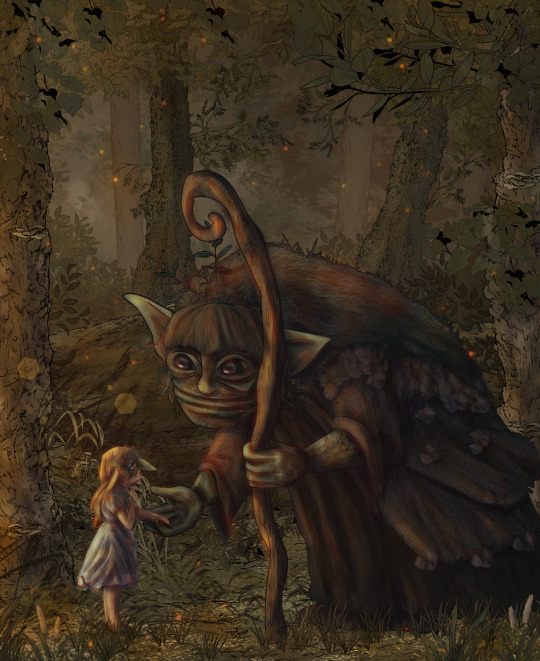
My drawing of a Shellycoat. Shellycoats are a type of Scottish water fairy that loves to play tricks, but doesn’t actually hurt anyone.
9 notes
·
View notes
Text
Shellycoat

A Shellycoat is a type of bogeyman that haunts rivers and streams in Scottish and Northern English folklore. Many places on the coast of Scotland have names that reference the shellycoat. Supposedly, shellycoats are particularly fond of the area around the River Hermitage.
Shellycoats are considered to be relatively harmless; they may mislead wanderers, particularly those they think are trespassing upon the creature's territory, but without malice. A common tactic of a shellycoat would be to cry out as if drowning and then laugh at the distracted victim.
Shellycoat
youtube
5 notes
·
View notes
Text
Shellycoat | Scottish Folklore
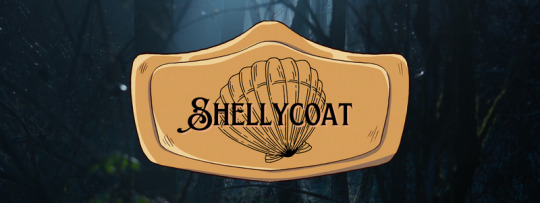
I always have a soft-spot for trickster types in mythology and folklore, so it might be of no surprise at all to hear that the Shellycoat is one of my favorite creatures from Scottish mythology. He is described as a huge monster who wears a coat of shells.
“He wore a strange garment covered in shells, the fearsome rattle of which appalled the stoutest heart. It was his custom; when he accomplished any task of difficulty, to doff this coat, and place it under a rock. Without this supernatural garb, he was rendered as helpless as those swan-maidens of ancient Teutonic myth, whose robes of swannsdown were easily filched from them when they were sleeping, and who might not then escape from mortal clutches.”
“A Water-Demon from Leith” from the The Scottish Review by Lewis Spence (1914)
Primarily from the lowlands of Scotland, he is often described as pulling harmless pranks.
"Like the Picktree brag and the HEDLEY row, Shellycoat delights in teasing, tricking and bewildering human beings, without doing them actual harm; and like robin GOODFELLOW, he applauds his success with loud laughter."
A Encyclopedia of Fairies by Katharine Briggs (1976)
My favorite story of a Shellycoat involves one who supposedly lived in an old house of Gorinberry, situated on the river Hermitage, in Liddesdale. This Shellycoat pretended to be a drowning person.
"Two men, on a very dark night, approaching the banks of the Ettrick, heard a doleful voice from its waves repeatedly exclaim, “Lost! Lost!”
They followed the sound, which seemed to be the voice of a drowning person, and, to their infinite astonishment, they found that it ascended the river.
Still they continued, during a long and tempestuous night, to follow the cry of the malicious sprite; and arriving, before morning’s dawn, at the very sources of the river, the voice was now heard descending the opposite side of the mountain in which they arise.
The fatigued and deluded travelers now relinquished the pursuit, and had no sooner done so than they heard Shellycoat applauding, in loud bursts of laughter, his successful roguery."
“Scottish Fairy and Folk Tales” by Sir Walter Scott (1893)
In Lieth, Edinburgh, there was a notorious Shellycoat that was said to never turn down a challenge, and was playfully bothered by children. According to local legend, he lived in a large rock (The Penny Bap), and children would dare each other to run around it three times while saying:
“Shelly-coat,
Shelly-coat gang awa hame,
I cry nar yer mercy,
I fear na yer name.”

The rock from that story was destroyed for construction of a dock.
.”..in the new dock operations his half-submerged rock was blown up or otherwise removed.”
“Cassell’s Old and new Edinburgh : its history, its people, and its places” by James Grant (1881)
After it’s destruction, the stories of the Shellycoat ended. What remains of it is now outside a sewage treatment plant.
4 notes
·
View notes
Text
Writer's Month 2023, Day 3: "Seashell"
Original fiction, specifically "the Fairy/Changeling WIP"
Word count: 406
Author's notes: One day, I'll know what the plot of this story is. In the meantime, more random drabbles to spitball ideas.
“That’s a lot of shells,” Everett murmured, watching as Gwenhidw sewed with quick, practiced motions.
She held up her work, which looked like a shirt made entirely out of tiny seashells—mostly white, with occasional spots or flashes of other colors. It seemed to shimmer in the dim light.
“It’s called a shellycoat. Do you know what that is?”
“No. I mean—I’ve never heard of it before, but I think I can figure it out from context.”
She laid her work back down, threading her needle through another tiny shell.
“Every shell was once a piece of a living creature,” she mused, adding it to the garment. “Can you imagine, how many millions of millions of millions have lived in all the waters of the world?”
Everett glanced at the coat, and the piles of shells waiting to be added to it, and thought back to how many shells he’d ever seen on all the beaches that he’d ever been to.
“And even when the creature dies, a bit of its essence resides in its remains. Our magic ties us to water, which ties us to all life. When woven with the right enchantments, we can harness the essences from the shellycoat to increase the wearer's power."
“Oh,” Everett said. Then, “It’s kind of creepy, now that you tell me it’s made from corpses.”
“Most things are made from corpses if you think hard enough.” She paused, then reached onto a nearby shelf, taking down a large conch shell. “Do they know, up in your world, that you can hear the sea inside of a shell?”
Everett took it from her. “Yeah,” he said, putting it to his ear. “But it’s just—”
He stopped in mid-sentence. What he heard was not the muffled echo of his own blood or the ambient noise of the room, but distinct, very definite sound of waves, of water churning and breaking and surging back. It was so clear that he could almost feel it the tossing sea around him.
Gwenhidw watched him with her large, dreamy eyes. “That shell has been enchanted to preserve its owner’s memory. It’s very old. What you’re hearing is how the sea sounded eons before your ancestors were born.”
“Sounds like it could have been recorded yesterday,” he murmured.
She nodded. "Even by our reckoning, the sea is very old."
She took the shell out of his hands and placed it reverentially back on the shelf.
#WritersMonth2023#Changeling WIP#Gwenhidw#is a figure from Welsh folklore so I guess she's worth tagging.#Shellycoat
1 note
·
View note
Text
if i had a copper for every time a hag wanted lorcan carnally id have two copper…
#they were both green hags too#lor cant escape the lustful shellycoats in any setting apparently#oc: lorcan#its the fey in him… delicious#nes.txt#this happened in dnd and bg3
4 notes
·
View notes
Text

Shellycoat
#heyo again posting in the ol tags#At a moral quandary but I guess I'll update yous on my life while I think of a way to sound it out#I am currently single. This is a big deal for me because I am coming to terms with my status as a serial monogamist#I think my ex has been not single longer than I have so I'm not feeling guilty about it. Just feels weird being single is all.#I'm doing the whole dating thing again. Have been on 2. First one I stayed at her spare room and freaking cried. Haven't spoken to her sinc#Second one I stayed in her spare room and she stayed with her roommate. Both times I didn't want things to go physical. Both over now.#The second one I was more optimistic for tho.Prominent thing was that she wanted me to date her and others. So I'm not exclusive with anyon#And I still maintain that. Doesn't feel good bc when I go on a date with one it feels like I'm cheating on the others.#But i have such low confidence that I don't want to turn anyone down or keep anyone waiting for me to ask them out. So idk what I'm doing#anyway. moral quandary. I just realized I can't actually talk about it. But I have to choose advancing my own career at the cost of my sou#it would be really nice to get some big £$£$ but I'd have to sort of betray new boss a little. Who has already given me permission to do so#it doesn't feel right. Shellycoat here is from new project. Ugh I dunno. I think I'm going o have to sell out just a little.#Bein single again shows me how behind I am for my age. Still can't drive still living with my best pal. Probably goin bald soon#then again I've been saying that for years now. Maybe I have a few years left of it. But yeah. I don't earn very much rn. When I get those#questionaires I'm often in the lowest bracket so i'm like “I am among the poorest of ppl then??” One lady stopped talking to me when I#told her I rented a flat. Which implies a lot of men my age own property already. But did they get them with their morals intact or did the#have to do a bit of backstabbing on the way? Anyway. I guess I'm happy that I'm not just whining about my love life.Maybe being single is o#still wanting to get out there. Maybe I'll make another post about that or whenever I'm not single lol
1 note
·
View note
Text
Green spring: Seelie and Unseelie
SEELIE AND UNSEELIE
Category: Scottish folklore
When people look up at fairies, usually one of the first thing they will stumble upon on the Internet is “Seelie Court and Unseelie Court”.
The Seelie and Unseelie Court (also known sometimes as simply “the Seelie fairies and the Unseelie fairies”) is a type of fairy division/fairy classification from Scottish folklore – and it is now one of the most famous classification of fairies in the modern world. According to this divide, the “Seelie” fairies are fairies that are generally benevolent towards humans: they return kindness, they can bring favors, they can ask for or give help, and if someone offends them they warn first before striking. These fairies are still dangerous, as all fairies are: like all fairies they are prone to revenge and mischief, but they are generally the “good guys” so to speak. In contrast, the “Unseelie” fairies are the malevolent and negative fairies, those that attack people without warning, and sometimes without reason, and ally themselves with witches and other dark entities of evil power. The “Unseelie” fairies include various negative entities of the folklores of the British isles: the baobhan sith taking the shape of a beautiful woman to lure and kill men, the redcaps who live in ruins and dye their hats with human blood, the nuckelavee who is a grotesque skinless centaur bringing disease and famine everywhere, the shellycoat who is a bogeyman of rivers, and the Sluagh (a host of malevolent fairies/angry ghosts/nocturnal spirits who you better not cross path with).
[Note that while the term “Court”, in modern fiction, has been reused numerous times with the modern meaning of “court” – having a queen and a king, and being made of nobility – the term seems originally to just be a word meaning a “host” or a “group” in general, since in Scottish folklore there is no talk of “Unseelie king or queen” for example.]
Now… all that being said, the divide of Seelie/Unseelie seems to be a latter addition or invention to the Scottish myth of the fairies. Before that, it seems there was just “Seelie” (it is clear that “Unseelie” was based on the word “seelie”): because “seelie” or “seely” was a term used in Scotland, but also in Northern England, to designate fairies as a whole. “Seelie” is a term that means “blessed”, “happy” or “lucky”, and it seems to have been used the same way fairies as a whole were called “good neighbors” or “the fair folk” – it was an euphemisms, or a counter-name, destined to flatter and please the supernatural beings, in hope of avoiding their wrath. It seems that originally “Seelie” was the name of all fairies as a whole, but then somehow the meaning got twisted into just meaning the good fairies, while a different name was created for the wicked fairies: “unseelie”, meaning “misfortunate, unhappy, cursed”. What is even more fascinating is that originally the term “seelie” was used alongside the word “wights”. “Seelie wights” – a word with an unclear meaning, but which was sometimes spelled “wichts”, leading to deformations as… “witch”. “Seelie witches”. The closeness of “Seelie” with “wights” and “witches” led in fact some scholars to wonder if the term “seelie” was actually used to designate fairies, or if it rather was used to designate a different type of supernatural being, different from fairies.
- - - - - - - -
Today, the Seelie and Unseelie Court is such a widespread and popular division you find it everywhere in fictional works talking about fairies. In modern “fairy fiction”, these two courts were most notably popularized by two book series:
# The Dresden Files: In the worldbuilding of this snarky urban fantasy series (bordering on the cosmic horror), the fairies are divided into two nations each dominated by a different Court, the Seelie Court ruling over the summer season, and the Unseelie Court ruling over the winter season. Each Court is ruled by a triumvir of fairy queens who embody the “Maiden-Mother-Crone” trinity: a Lady, a Queen and a Mother. Titania is the queen of the “Summer Court”, while Mab is the queen of the “Winter Court”. The Dresden Files notably challenges the idea that the Seelie and Unseelie Court are based on morality: while it is the stereotype common in this world, in truth the Unseelie fairies are not “evil”, they are cold, ruthless, calculating beings of ice, death and darkness. Meanwhile the Seelie fairies are beings of life, light and warmth, yes, but they can be as chaotic and destructive as hot jungles or thunderstorms, and they are not fairies of “goodness”. “The Dresden Files” is notorious for bringing the whole idea of “Seelie/Unseelie=Winter/Summer” which wasn’t something before its release…
There was a concept of the fairy courts being associated with cold and heat before The Dresden Files though: it was the elf-courts in “The Discworld” series by Terry Pratchett (which was a main source of inspiration for The Dresden Files). In Pratchett’s world, the elves of the Discworld (a cross between a parody of the Tolkienesque elves and the “fair folk” of British legends played for full horror) are divided between a court centered around a Queen, who lives in perpetual frozen wastelands of endless winter, and a second one centered around a King, instead hiding in a very hot, very moist, warmth and humid underground realm of vapor and sweat.
# Another big influence on modern perception of the Unseelie and Seelie Court was “The Shadowhunter Chronicles”, where the fairies are also divided in two nations each ruled by one of these courts. No seasonal theme here – rather the Seelie Court is focused on appearing as beautiful, helpful and benevolent as possible, while still being deceptive and manipulatives, while the Unseelie Court is openly and proudly cruel, violent and monstrous. The Seelie Court is ruled by a Queen, while the Unseelie Court is under the domination of a King.
Interestingly, the same way “The Dresden Files” was inspired by “Discworld”, it seems the concept of “The Shadowhunter Chronicles” of the two courts being divided between beautiful subjects of a fairy queen and the monstrous subjects of a fairy king was inspired by an older work of the 80s: “Faerie Tale” by Raymond E. Feist, a horror novel based on fairy folklore. In it, we end up learning that somehow after the events described by William Shakespeare in his “Midsummer Night’s Dream” play, Titania and Oberon (or at least the beings Shakespeare described by this name) ended up splitting their fairyland into two distinct part, separated by a dusk-plunged, haunted, no-man’s land called the “Shadow Lands”. On one side is the Bright Lands, a fairyland of endless day where the sweet and kind Queen rules over pleasant, charming and joyful fae, who are benevolent and helpful towards humans, but still dangerous to live with due to their alien ways of thinking, strange customs and hazardous magical powers. On the other side, the King lives in the Dark Land, a realm of endless night where he rules over monstrous, grotesque, hateful and murderous fae who only wish to invade the human world and destroy mankind.
41 notes
·
View notes
Text
Gonna make a reverse 1999 monster AU master post one of these days, but here’s the current monsters:
Vertin: Frankenstein inspired creature
Sonetto: Werewolf
Schneider: Vampire (Ty Parzi on twt for this idea)
Matilda: Harpy
Mesmer Jr: Mara
Regulus: Brownie/Shellycoat inspired
Erick: Norwegian troll, but a small one
Cristallo: Myling
Pavia: Werewolf
Sotheby: Witch
Balloon Party: Changeling
Horropedia: Cynocephaly (human body, dog head)
Blonney: Faun
Jessica: Centaur (obvious I know)
Druvis: Huldra/Skogsrå
Onion: Dullahan inspired
X: Black eyed child
Sweetheart: Xana
Click: Ghost (mist)
Twins Sleep: Doppelgänger (both, original human is their “big sister”)
Poltergeist: Ghost (Walker)
Mondlicht: Selkie inspired
Eternity: Strigoi inspired (a type of vampire)
Pickles: Black Dog
That’s all I got for now but I’ll add onto it if anyone wants more of this cuz I find it a very charming idea!
*note: heavily inspired by folklore and my own OC worlds + films. Sometimes I might get things wrong in terms of folklore, or do something unintentionally insensitive (resources are limited). If you are more familiar with that folklore/culture, please let me know!
9 notes
·
View notes
Text

Inktober: Shellycoat
ID: Simple ink line drawing of a vaguely humanoid creature covered in what looks like seaweed, including different kinds of shells. The seaweed mimics hair or fur. The being has a toothy grin and a lanky hand. End ID
12 notes
·
View notes
Text
Worldbuilding: The Fastest Ship on the Water
If your characters are traveling, you want to know where the rivers are. For many reasons. Rivers are water sources. Obstacles. Territorial boundaries. And trade routes. The history of civilization is a history of rivers. The Nile, the Yellow River, the Tigris and the Euphrates, the Danube; these are some of the better known. But every river has its own history, and its own challenges.
There can be a lot of obstacles to crossing a river beyond “the bridge is out”. A flood is a classic reason for said bridge to be out, and nothing sane people want to mess with. River monsters are another classic obstacle; from the mundane like alligators and Nile crocodiles, to exotic electric eels and piranhas, to supernatural gargoilles and kelpies. (See also shellycoats, water bulls, hellbenders, and a host of lesser-known water monsters. Water cougars are an Appalachian thing. Seriously.)
But what about a flood that’s broken an ice dam upstream, so your heroes are dodging ice chunks? Or the more businesslike hazard of loose rafts of timber being floated downstream to a mill? Floating at speed, turning and bumping, with all kinds of jagged, lung-puncturing branch ends sticking out. Death by logroll is not how your characters want to go!
Neither is getting shot by the guards of the next kingdom waiting on the far bank for spies and enemy scouts. Or captured and keelhauled by river pirates. Yes, river pirates are also a thing. Wherever you have commerce, you have pirates. And given how much less muscle power river shipping takes versus overland caravans, there is a lot of river traffic. Even if it’s slower than a straight line.
And sometimes it’s faster. Much faster.
Pre-airplane, and even for a few decades post-airplane, rivers were not only the cheapest, but the fastest way to bring cargo between places.
...But only when they were frozen.
It is, in fact, possible to put ice skates on a sailing ship. Note, you want to pick the right ship. Some designs are more dependent on the force of water holding them together than others. But if your hull can take the strain, and your mast and sails can take the winter wind - ice-rigged ships are fast. Some can reach four times the wind speed; over 100 mph is quite doable. Ice-rigged boats on the Hudson raced trains - and won.
Of course, this only works if the river freezes hard enough to support a ship. But if it does... instead of winter being a time when nothing moves, it might be when everything moves. The savings in time and energy, when wind just has to push runners over ice instead of a whole hull through water, are phenomenal.
Not to mention, picture a fleet of iceships charging down on a hapless enemy at speed. Zoom!
3 notes
·
View notes
Photo
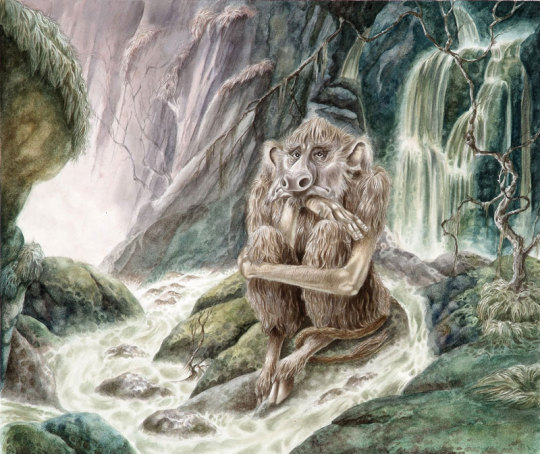
The Urisk [Scottish mythology]
It is generally accepted that the fey creatures of Scottish myths can not be trusted. They are notorious for bringing all kinds of supernatural trouble, but there are exceptions. The Urisks, for example, were harmless and had generally no intentions of hurting anyone, instead preferring a peaceful life of solitude.
Perhaps they owe their peaceful character to the fact that they are only half fey creatures, for it is said that the Urisks are the offspring of fairies (the Leannan Sìth) and humans. Some believe they are synonymous with the Brownies – Scottish household spirits – but they differ on several key characteristics. Most notably, the Urisks do not dwell in places inhabited by humans, but only live in remote locations such as deep forests, caverns or mountaintops.
Physically, these creatures had a humanoid appearance but they were larger and had a grey skin. Like humans, they can be both male and female. Travelers who intruded on the domain of an Urisk sometimes saw the creature sitting motionless on a rock, staring at the intruder. They could only be seen during the evening, presumably they hide during the day. Rarely, they speak to humans, and there are accounts of them physically attacking people (which kinda contradicts my earlier point about them being peaceful, but as I understand it, this is not the norm). Usually however, Urisks choose to not interfere in the affairs of humans. And in rare occasions, an Urisk helped a traveller in need.
But folklore is hardly an exact science and there are some tales of Urisks who did interact with humans. For example, the Urisk of Breadalbane (southern Scottish Highlands) only lived on its mountaintop during the summer months. In the winter the creature was cold and came down to human settlements. It warmed itself in their houses and, in return, performed work for the farmer.
A similar situation could be found in Tyndrum: the Urisk of a neighbouring hill came to the village during the winter. It was encountered by Saint Fillan however, and the holy man banished the creature to Rome. I cannot find the details of this story so I am uncertain why he did this.
As I pointed out earlier, Urisks generally prefer to leave humans to their own devices. But people who are kind and respectful to them can gain their favour and the Urisk can choose to help them by performing all kinds of tasks.
There is some conflation between the Urisk, the Brownie and the Shellycoat, all three of which are sometimes used interchangeably but their origins are not entirely certain. Some authors regard the three as being different names for the same creature, while others hold that the Urisk is a separate being.
Sources:
Campbell, J. G., 1900, Superstitions of the Highlands & Islands of Scotland, Glasgow University Press.
Keightley, T., 1870, The Fairy Mythology: illustrative of the romance and superstition of various countries.
(image source: Andrew Skilleter. You can purchase a print of this artwork on the artist’s website: andrewskilleter.com)
56 notes
·
View notes
Text
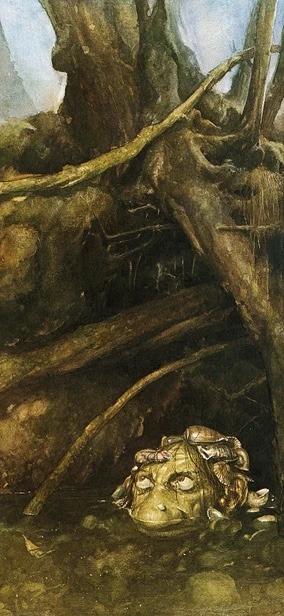
Shellycoat by Alan Lee in the book Faeries
#shellycoat#mythology#folklore#mythological creature#myth#scottish mythology#scottish folkore#scottishfolklore#scottish#scottish folklore#art#FairyArt
1 note
·
View note
Text
Shellycoat
Shellycoats are considered to be relatively harmless; they may mislead wanderers, particularly those they think are trespassing upon the creature's territory, but without malice. A common tactic of a shellycoat would be to cry out as if drowning and then laugh at the distracted victim.
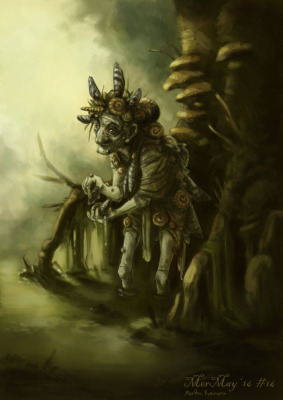
As described above, the shellycoat shares many of the traits of the Brag, Kelpie and Nix.
Jacob Grimm stated in his Deutsche Mythologie that the Scottish goblin Shellycoat is one and the same as the German Schellenrock, that is bell-coat:
A pück [home-sprite] served the monks of a Mecklenburg monastery for thirty years, in kitchen, stall and elsewhere; he was thoroughly good-natured, and only bargained for 'tunicam de diversis coloribus, et tintinnabulis plenam.' [a "parti-coloured coat with tinkling bells"] In Scotland there lived a goblin Shellycoat, and we saw that the dwarfs of the Mid. Ages also loved bells [schellen; and schellenkappe is Germ. for cap and bells]. The bells on the dress of a fool still attest his affinity to the shrewd and merry goblin (fol, follet); see Suppl.
Thomas Keightly quotes Grimm and classifies the shellycoat as a type of brownie.:
Another name by which the domestic spirit was known in some parts of Scotland was Shellycoat, of which the origin is uncertain.
The domestic nature of the shellycoat emphasized by Grimm and Keightly stands in contradistinction to the wild nature of the water sprites mentioned in other sources.
1 note
·
View note